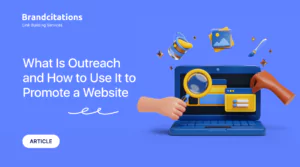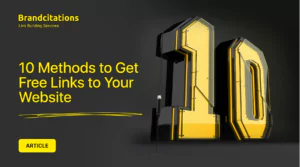How to Write the Perfect Outreach Letter

There are many link building tactics, and the effectiveness of most of them depends on the webmaster’s ability to communicate with site owners. This is especially true for guest posting and outreach.
In our previous article, we explained what outreach is and how to use it to promote your site on Google. If you’ve already read that material and are ready to take action, this new article will answer all your questions.
Today, you’ll learn how to write effective outreach emails. We’ll cover common mistakes, show you how to build the optimal email structure, and share useful tools that help automate part of the process when sending email sequences 🤫
How Emails Affect the Effectiveness of Link Building
When buying backlinks through link exchanges, SEOs rarely communicate directly with site owners. Thanks to automation, the purchasing process involves minimal interaction between both parties.
Outreach is the most demanding method of link building. Outreach specialists are often forced to sharpen their email marketing skills.
The success of outreach as a link building strategy depends heavily on the quality of the emails sent to site owners. If the emails are generic or poorly written, responses can take months — or may never come at all.
The first step is sending a «cold email», which should ideally initiate a conversation between the two parties. In the best-case scenario, the site owner opens the email, responds promptly, and a discussion about collaboration begins.
High-quality outreach emails solve the following tasks:
- Reduce response time. If a webmaster receives dozens or even hundreds of emails daily, they tend to reply selectively.
- Establish initial contact. The recipient may not respond right away, but if they open and read your message, the likelihood of future engagement grows.
- Handle unconventional requests. If your goal isn’t just to place a link but to run a promo campaign or explore a unique advertising format, a creative email can open that door.
- Foster long-term partnerships. A positive first collaboration lays the foundation for future direct contact through other communication channels.
- Avoid the spam folder. If your message doesn’t reach the inbox, your chances of closing a deal drop to zero.
The formula for an effective outreach email consists of several components: relevance, personalization, creativity, and technical setup. Relevance can be tricky to get right, but the technical setup only needs to be done once — after that, the process becomes more streamlined.
Beginner link builders who are new to outreach should understand that there is no perfect email template. Even if you use a well-performing example from the internet with high open and reply rates, your results may still fall short.
The Main Mistakes in Writing Outreach Emails
Many successful link builders don’t know how to write outreach emails simply because they’ve never worked with this method of link building and have relied on relatively straightforward tactics.
Links from social profiles, directory sites, forum links, guest posts, and other link-building techniques require some skills — but it’s in outreach where a specialist’s true expertise is put to the test.
Not everyone can write an email that gets a same-day reply — let alone a positive one. Even top link builders sometimes miss the mark, but most of the time, they succeed. Let’s look at the most common mistakes that prevent you from getting links from high-authority donors.
Before writing an outreach email, put yourself in the website owner’s shoes and view every mistake from their perspective. Imagine receiving dozens of emails every day and having to sort through them to find the ones worth your attention.
The email is poorly formatted
While business communication is increasingly moving to messengers — where formatting is less important — email outreach requires a more structured approach. In outreach emails, it’s essential to highlight key points, but without overdoing it.
Draw attention to things like pricing and your unique selling proposition to help the recipient quickly grasp the most important information. A lack of paragraphs, active links, bullet points, and other formatting elements significantly lowers the reply rate.
How it should be done:
- consistent font;
- consistent font size;
- clear paragraph structure;
- highlighting of key points.
Spelling and Meaning Errors
Many webmasters use ready-made outreach templates, change the basic details, and send them off, hoping to close a deal quickly. A week or two goes by, and still no response. Upon re-reading the letter, it turns out the recipient’s name is wrong, the offer is unclear, or the content refers to a completely different site.
This mistake is common among beginners, but even experienced link builders occasionally slip up. Before hitting the «Send» button, read the letter several times and make sure it’s free of major errors.
How to:
- Check that the content is up to date
- Have it proofread by a native speaker if you’re writing in an unfamiliar language
- Read it several times and make it as concise as possible
- Use tools to check for spelling and punctuation errors
Strange Email
Imagine receiving a message from «James34», whose email address is just a random jumble of letters and numbers. He takes forever to get to the point, and you feel like the two minutes spent reading it were a waste.
When we open our email client, we immediately notice the subject line and the sender. If, at first glance, there’s no desire to click on the email, the sender is likely to be ignored.
How to:
- An email address on your own domain (optional);
- A thematic email address in the format «ma*****@do****.com» or «ma**************@do****.com»;
- A personalized profile: a completed profile, photo, and signature.
Irrelevant subject line
Whether the email gets opened or sent to the trash largely depends on the subject line. While there’s no guarantee an outreach email will be read, a compelling subject line is the first step in initiating a conversation. From there, everything depends on the email’s content structure and how relevant the offer is to the webmaster.
The sender’s name and subject line should be crafted to spark the recipient’s interest — or at the very least, to avoid being flagged as spam. In this case, the rule «the simpler, the better» applies.
How to:
- 30–50 characters long
- The subject line should clearly convey the core of the proposal
- Keep creativity and clickbait to a minimum
- Focus on personalization
- Address the recipient’s «pain points» — the offer should solve a problem the webmaster is facing
Lack of personalization
Mass mailings using templated letters have become tiresome for most recipients — especially for owners of large websites, who receive dozens of requests daily. They tend to open their inbox with little enthusiasm, scanning for something worth their attention.
Personalization should be strong enough to make the potential partner want to open the email and, after reading it, feel that the offer is genuinely relevant and valuable to them.
How to:
- introduce yourself and your project;
- research the recipient and understand the specifics of their work;
- address the recipient directly;
- focus on a personalized offer;
- avoid excessive flattery and stick to the point.
Direct offer
Few people enjoy reading long, templated emails. In SEO, much of the work is routine, and if a webmaster regularly earns from outreach, they’ll read most of the incoming emails — but some may be pushed aside.
The key sales rule in any niche is: «Don’t start selling right away». Initiate a conversation, introduce the context, and then move on to the details of the deal. However, it depends on the situation — if the «Link Placement» section explicitly states that the contact person dislikes small talk, get straight to the point.
How to:
- introduce yourself and compliment the recipient and their website;
- provide information about your project;
- clearly state the objective;
- explain the nature of your request;
- ask for additional details.
Lack of examples
This mistake often arises when the goal is not just to insert a link into an existing or new article, but to build a long-term partnership. If you aim to publish multiple guest posts, providing successful examples is important.
Use examples carefully — if they don’t align with the specifics of the project, it may backfire. A potential partner might realize that the advertiser didn’t analyze their site and simply relied on outreach templates.
How to:
- 2–3 examples;
- examples relevant to the task;
- examples that highlight the benefits of collaboration.
Blurred Call to Action
Imagine receiving a well-written email offering a high price for a backlink — your hand reaches for the «Reply» button, but something holds you back. The issue is the lack of a clear call to action. The recipient must understand exactly what to do to continue the conversation.
If you’re hoping to connect with the webmaster via messenger or request the contact of the person responsible for link placements, make sure to clearly direct their attention to that specific action.
How to:
- Provide a clear step-by-step action plan;
- Explain the optimal anchor text, type of link, and the desired number of placements;
- Include any additional details that may influence successful collaboration.
No question at the end
A vague call to action often overlaps with the lack of a closing question that prompts a reply. For example, the email might be well-written and contain all the necessary information, but the recipient is still left wondering, «What’s next?».
If the offer is compelling enough, they might respond anyway — but they might not. That’s why every outreach email should end with a clear question that signals the next logical step and encourages the recipient to take action.
How to:
- End with a clear question;
- Ask something that invites a conversation;
- Personalize the question to the recipient;
- Reiterate the benefits of the proposed deal.
No signature
One of the main mistakes in outreach email marketing is including a long introduction at the beginning. SEOs often talk about their experience, achievements, and other irrelevant details. It’s better to place your profile at the end, as it has minimal impact on the deal.
Keep in mind that people usually skim emails, so they’re unlikely to spend time reading through your case studies. It’s more effective to include key information about yourself after the main body of the letter.
How to:
- first name (and possibly last name);
- position;
- availability hours;
- relevant additional information.
No communication channels
Some webmasters who regularly post links use email as their primary work channel. However, others prefer to resolve issues quickly via social media or messaging apps.
If your message doesn’t include alternative contact methods, the chances of a prompt reply drop significantly. And if the webmaster has 50 messages ahead of yours, it could take a week or two before they even see it.
How to:
- include links to social networks and messengers at the end of the email;
- mention your availability;
- indicate your preferred communication channel.
Email marketing mistakes are easier to understand through outreach email examples. There are plenty of templates online, but not all of them are well-crafted.
The Optimal Structure of an Outreach Letter
As we’ve already mentioned, there are no perfect templates, and the results achieved by other specialists will vary from case to case. The benefit of ready-made templates is that they can reveal non-obvious approaches to solving a task.
The structure of the email can vary depending on the goal and the recipient. If you’re certain that a brief commercial offer of just a few lines will suffice, writing a full-length email isn’t necessary. However, it’s generally better to go the extra mile than to fall short.
The optimal structure of an outreach letter:
- Greeting
- Compliment
- Purpose of the proposal
- Call to action
- Signature
- Additional communication channels
Each of these points can be expanded endlessly, but nothing beats practice. Once you’ve sent a few hundred personalized letters, you’ll be able to find the optimal formula for your specific project or broader strategy.
The main advice is to research both the project and the recipient. The more information you gather, the higher your chances of securing a link from a popular resource. Over time, you’ll build a solid foundation of trusted backlinks that will serve as the perfect base for successful site promotion.
How to Increase the Effectiveness of Outreach Mailings
It’s time to move on to practical tips that can significantly boost the effectiveness of your outreach campaigns. Analyze them carefully and apply them in practice to build successful outreach strategies and generate consistent results.
All the tips are based on hands-on experience. Some may seem obvious to seasoned link builders, but the success of any SEO task often lies in mastering the fundamentals.
Choose the Right Time to Send
Your email may be well-written and backed by a solid link placement budget, yet still receive no response. The issue often lies in timing — if the message arrives at the wrong moment, it can easily get buried among other emails before the recipient sees it. So, when is the best time to send an outreach email?
Aim for the optimal sending time. In most cases, that’s weekday mornings when webmasters check their inboxes and begin reviewing offers. Marketers often recommend sending emails on Tuesdays and Thursdays at 8:00 a.m. or 5:00 p.m., but keep in mind that general statistics may not apply to every situation.

Send Follow-Ups
A successful outreach sequence usually involves three or more «touchpoints». In some cases, the task can be completed in just two steps — especially if all necessary details were included in the initial email and there’s nothing left to clarify. In such cases, you can move straight to business.
In email marketing, these repeated messages are known as follow-ups. Don’t hesitate to send follow-ups, as long as you’re confident that a reminder won’t damage the positive impression you’ve made.
Follow-up emails can be spaced out over 7–10 days. Outreach campaigns almost always rely on multiple messages, and without follow-ups, it’s unlikely you’ll achieve the desired results. According to experienced email marketers, even a single follow-up can boost the reply rate by 50–100%.
Use automation tools
If you’re planning to send just 10 emails, using automation tools isn’t essential — though even then, they can save you time.
Those who don’t handle outreach at scale typically manage with a basic email client and pre-made templates. But if you’re aiming to build a long-term link-building process, equip yourself with tools that simplify routine tasks.
We recommend using:
- Ahrefs: for SEO analysis of potential link donors;
- Snov.io: to verify email addresses, launch trigger-based mailings, track emails, and handle other tasks;
- Pitchbox: for running outreach campaigns in international markets;
- Hunter.io: to quickly find email addresses on websites;
- Mailtrack: to track email open status within Gmail;
- GMass: for bulk emailing via Gmail;
- WiseStamp: to create professional email signatures;
- Contacts+ for Gmail: to build profiles of your contacts;
- Sortd for Gmail: to organize emails by status using kanban-style boards;
- Airmail or eM Client: to send emails from both desktop and mobile devices.

We recommend paying special attention to Reply.io and Snov.io, which allow you to send automated email sequences. These sequences follow the structure of a main email followed by scheduled follow-ups over several days. This approach significantly boosts outreach effectiveness.
Use ready-made templates for outreach
There are many ready-made examples of outreach emails available online. These show who to write to, how to approach it, and which points to emphasize. Templates should not be viewed as a one-size-fits-all solution for a specific task. Instead, they serve as a guide to point you in the right direction.
Good examples of outreach emails can be found in the template library of Lemlist, a service that positions itself as the ideal tool for automating outreach campaigns. Feel free to use their email templates for outreach. The list includes options for various tasks, ranging from finding partners for a digital studio to boosting sales for a SaaS service.
Improve your email marketing skills
Outreach is not just about creative emails; it’s primarily about deep analysis, automation tools, and a variety of secondary tasks that gradually lead to solving the main objective.
In conclusion, we want to emphasize that outreach campaigns require maximum focus and non-stop effort. If you apply our tips in practice and streamline the process, you’ll need to manage a high volume of incoming emails.




